► CAR’s first-ever electric Sports Car Giant Test
► Performance EVs from all corners
► Which is the one we’d keep the key to?
A new generation of electric performance cars has arrived. We’ve collected a bunch of them from all corners of the car world, including super-saloons, SUVs, hatches and even a hypercar for the ultimate for the ultimate battle. Did they remember to pack the fun? You bet they did – bags of the stuff.
EVs for petrolheads: the cars
Automobili Pininfarina Battista
Twinned with the Rimac Nevera but engineered with a distinct character, the Battista’s numbers are as otherworldly as its beauty, as befits a name that’s graced many of the most beautiful cars ever created. The core of the car is a carbon tub, a 120kWh (gross) T-shaped battery and four e-motors; 334bhp for each front motor, 603bhp for each rear unit.
Price From £1.7m (£2.65m as tested)
Powertrain 120kWh battery (gross), four e-motors, all-wheel drive
Performance 1874bhp, 1726lb ft, 1.86sec 0-62mph, 217mph (limited)
Weight 2063kg
Efficiency 296-mile range (official)
Read our Automobili Pininfarina Battista review
BMW i5 M60
The M version of the new 5-series electric twin. The position of the letter M in the name is key – this isn’t a CO2-free M5. Instead it’s a very fast, very capable i5. And that might be just what you’re after.
Price From £96,840 (£115,245 as tested)
Powertrain 84.4kWh battery (gross, 81.2kWh usable), twin e-motors, all-wheel drive
Performance 593bhp, 605lb ft, 3.8sec 0-62mph, 143mph
Weight 2130kg
Efficiency 320-mile range (official), 240-mile range (tested)
Read our BMW i5 review

Porsche Taycan Turbo GT
For the duration of the first-generation Taycan’s lifespan Porsche was, like a lion being bothered by flies, happy to let the likes of the Model S win the performance hype war. But no longer. Turbo GT treatment transforms the four-door coupe into something like a zero-emissions GT3, albeit with most mod cons still in place.
Price From £186,300 (£192,024 as tested)
Powertrain 105kWh battery (gross, 97kWh usable), twin e-motors, all-wheel drive
Performance 1093bhp, 988lb ft, 2.2.sec 0-62mph, 190mph
Weight 2220kg
Efficiency 344-mile range (official), 271-mile (tested)
Read our Porsche Taycan Turbo GT review
Lotus Eletre R
Lotus as we know and understand it ends with the Emira. The Eletre is different – this is where something else begins. The first truly Geely Lotus, designed in Coventry and built in China, it’s a vast premium SUV hoping to do for Lotus what the Bentayga has done for Bentley.
Price From £120,000 (£163,195 as tested)
Powertrain 112kWh battery (gross), twin e-motors, all-wheel drive
Performance 905bhp, 726lb ft, 2.95sec 0-62mph, 165mph
Weight 2490kg
Efficiency 304-mile range (official), 240-mile range (tested)
Read our Lotus Eletre review
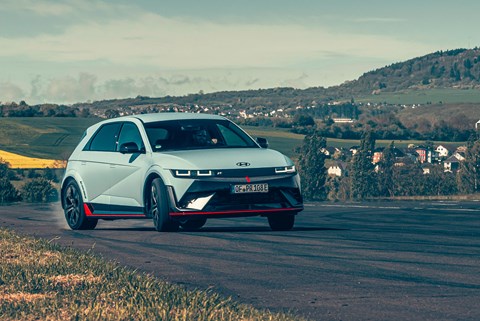
Hyundai Ioniq 5 N
The recipe is simple but twisted. Take that weird-looking but successful family EV and hot rod it with beefier dampers, reinforced subframes, bigger brakes and a new, quicker steering rack. Oh yeah, and stitch the body together with an additional 42 welds and 2.1 metres of structural adhesive so it won’t tear itself apart.
Price From £65,000
Powertrain 84kWh battery (gross, 80kWh usable, est), twin e-motors, all-wheel drive
Performance 641bhp, 546lb ft, 3.4sec 0-62mph, 162mph
Weight 2235kg
Efficiency 278-mile range (official)
Read our Hyundai Ioniq 5 N review
Tesla Model S Plaid
Peak Tesla if you’re into really big numbers, the Model S Plaid is the wildest non-Cybertruck machine to emerge from Musk’s eco-system. It’s a bonkers plaything, capable of firing itself up a drag strip or down a rural back road quicker than you can say ‘Mummy!’ before then streaming whatever show you like on the screen as you hook up to a Supercharger.
Price From £115,630
Powertrain 100kWh battery (est), twin e-motors, all-wheel drive
Performance 1006bhp, 1050lb ft, 2.1sec 0-62mph, 200mph
Weight 2265kg
Efficiency 373-mile range (official)
Read our Tesla Model S Plaid review
Lucid Air Dream
In many ways the sequel to the Model S (Lucid CEO and CTO Peter Rawlinson was the brains behind Tesla’s game-changing saloon), the Air uses ultra-compact, ultra-efficient components to create a long-range luxury EV with apparently limitless cabin space. Due soon in Europe, but yet on sale in the UK.
Price From $109,900 (Air Grand Touring)
Powertrain 118kWh battery (gross), twin e-motors, all-wheel drive
Performance 1006bhp, 1025lb ft, 2.6sec 0-60mph, 173mph (limited)
Weight 2396kg
Efficiency 471-mile range (EPA official)
Read our Lucid Air review
Plug & Play: the test

High in the hills, snug in the Pininfarina’s speeding carbon monocoque, its Group C-style bubble screen full of Solar Yellow Lotus, my brain’s running way beyond its rev limiter (forgive the archaic reference). But for a moment, between oh-so-careful applications of the long-travel loud pedal (and it really is loud), I free up just enough mental capacity to consider the concept of exponentially accelerating change; flashes of profound progress separated by shorter and shorter intervals until, like strobing street lights playing across the shell of a flat-out Battista, those moments coalesce into a seamless streaming singularity.
Change certainly feels like it has its foot to the boards. Until the tail end of the last decade, Carrozzeria Pininfarina was an Italian design house and coachbuilder, not a car maker, and Lotus was a perennially cash-strapped sports-car marque synonymous with mesmerising handling, borrowed K-series engines and clever work with glue. If, in early 2019, you’d told me that in 2024 I’d be chasing an all-electric Lotus SUV in an engine-less Pininfarina in a surreal game of 2779bhp kiss chase, I’d have bought you a bottle of water and called for medical assistance.
But here we are – for now, at least. But where, exactly? In the calm-ish before the storm, I’d suggest. Last time we gathered together the world’s most exciting electric cars, in May 2022, we learned two things: that the Porsche Taycan GTS was the best EV for petrolheads; and that there was still a long way to go. And soon we’ll see two pivotal performance EVs: Porsche’s electric Cayman/Boxster and Ferrari’s e-hypercar.
All of which means that right now we’re experiencing performance EV version 1.5; faster, more efficient, smarter. But genuinely thrilling? And alive with any of the delicacy, precision and facility for dynamic dialogue common to all the great piston-engined performance cars of the past? First impressions, garnered at the Nürburgring and the roads around it, would suggest rampant progress.
On a short dash between uphill hairpins the quad-motor Battista closes the gap to the Eletre R, huge torque effectively flattening the climb, working Cup tyres like so much pizza dough and heaving at my spleen. As impressive as the Pininfarina’s speed is the rate at which you learn to trust the car, its incomprehensible performance (0-62mph in 1.86 seconds – not long ago this was simply the fastest car in the world) made usable by layers of polished development in every area, from driving position and control weights to electronics and torque distribution.
Come off the well-judged brake pedal (a smidge of give at the top of the travel, followed by meaty and precise retardation), crane your neck to see where the road goes next and sweep the nose in with a roll of your wrists. The steering is light and accurate rather than drenched in feel, but being able to precisely place what isn’t a small car feeds into your growing confidence. And just as the silhouette is classic hypercar, the two-seat bubble cockpit at the head of a streaking comet’s tail of bodywork, so the driving experience transcends the powertrain paradigm shift to feel timeless somehow. The ease with which the car moves on the road, its apparent mastery of the problematic physics that plague lesser machines, and the barely conceivable performance advantage it enjoys over mortal traffic all call to mind the likes of the LaFerrari and McLaren’s 750S. And this at a relative canter…
The road opens out, the Lotus pulls in and the Battista and I take a moment. Sunshine blazes through gaps in the trees, warming the tarmac and creating a cinematic mist through which the Pininfarina punches like an earthbound projectile. I just can’t stop smiling. The cabin is cosy but comfortable, and you’re keenly aware that, crucially, unlike every other car here, you sit millimetres above the speeding tarmac, not a slab of cells. The T-shaped battery is packaged around you rather than beneath you, lowering the centre of gravity and putting you right where you want to be, rather than a couple of inches above it.
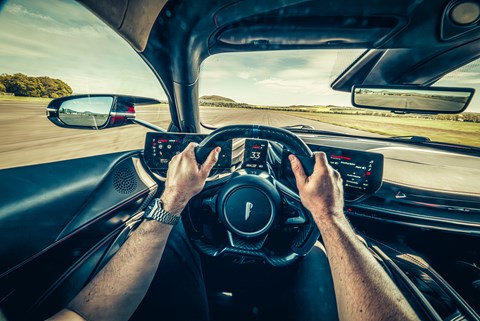
The road – smooth and empty and mostly dry now – tumbles across an undulating landscape. Reaching down, I twist the drive mode controller up from range-boosting Calma (just 671bhp…) through road-perfect Pura, with its delicious primary ride quality, to Energica, effectively Sport in anyone else’s book. (In reserve for now are frantic Furiosa, which feels about as road-appropriate as using a nuclear warhead to remove a stone stuck in your shoe, and configurable Caraterre.)
The Battista’s sonic signature, a curious but not unpleasant ‘idle’ that starts the moment you wake the car, pulsing at a frequency you feel as much as hear, grows more intense, waxing and waning with changes of throttle position and speed. A weird idea on paper, it’s inspired in practice. For one you’re never in any doubt that the thing’s armed and ready for action – not always a given with EVs. And on the move the effect is mesmerising, its sci-fi intensity coming on strong over the pings of flying road debris, clicking systems and gurgling coolant to ramp up the emotional heft of this already affecting driving experience.
I’m fully getting carried away now, greedily delving deeper into the car’s oceanic reserves of power like a child with its arm jammed deep in the biscuit barrel. Commuting Passats are seen, passed and dropped in a heartbeat. As we build speed the noise grows more and more thrilling, the very real whine of the front e-motors coalescing with the synthetic soundtrack to create an orchestral racket which, while some way short of a V12 at full cry, is at least light years ahead of most other EVs.
Round one and the Battista’s landed a couple of big hits. When the time comes to climb from its cockpit, the battery having been depleted at a rate of 1.7 miles per kWh (testing manager Luca Tarter reckons 180-ish miles of range is more likely than the official 296 given the Garden of Eden-esque levels of temptation), I do so reluctantly, and with the racing heart rate and rictus grin of an addict. To paraphrase Steve McQueen, Battista is life. Anything that happens before or after is just waiting.

In need of urgent recalibration, I seek out the key to the Lotus. It is gorgeous – a tiny, pebble-smooth triumph so beautifully sculpted you barely feel it in your pocket. I’m talking about the key, obviously: there’s nothing faintly pocket-sized about the car. But that this is the nicest car key I’ve ever used is an interesting first lesson in the level of love and attention to detail with which the Eletre’s been created. Yes, at rest its scale is more shipping container than sports car, even as design boss Ben Payne’s laudably original sculpting works its socks off to mask the car’s sheer size. Has there ever been a more tempting car to dismiss having not even driven it? I doubt it. But to do so would be both wildly unfair and a crying shame.
The cabin is spectacular. Original, gorgeously comfortable and unlike any Lotus before it, it is a towering achievement and a wonderful space in which to spend time. There’s legroom for miles and a level of finish light years ahead of anything Lotus has managed previously. Think Bentley in terms of substance, if not style.
It all works, too. I’m a big fan of round steering wheels (if it ain’t broke…) but the Eletre’s alcantara-wrapped hexagon feels fabulous in your hands, the view ahead a single sliver of digital display like a McLaren with its instruments folded in circuit mode. Behind the wheel the twin paddles serve two functions, moving about a horizontal rather than a vertical pivot, such that pulling the upper section intuitively ramps up the same thing that tugging the lower section dials back. On the left that’s regen effort; the right, drive mode. Sounds complicated, but it’s a mark of the essential rightness of the idea that it feels second nature within 20 minutes, and adds hugely to the driving experience.
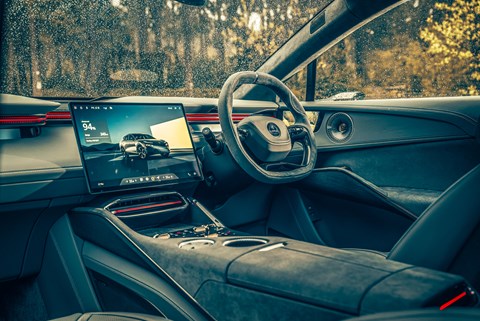
That the Eletre isn’t a ‘true’ Lotus brings plenty of good news with the bad. The seats are 12-hour-day comfortable yet supportive. The speaker grilles are works of art, as are the rocker switches. The app looks great and works beautifully. And the central interface and its underlying UX make accessible in one small piece of touch-sensitive real estate what you’d need a cathedral of buttons to manage.
Disabling the now-mandatory lane-keep assist and speed-limit warning takes all of four seconds. Driving through a tight car-park exit barrier? Tap the camera icon and the omni-directional feeds let you place this huge car with pinpoint precision. The digital wing mirrors feel normal within 100 miles. And while hardly the last word in efficiency (a disappointing two miles per kWh during restrained motorway driving), leapfrogging from Lincolnshire to the Eifel mountains via the Ionity network, while cripplingly expensive at 70p per kWh, is hassle-free thanks to reliable charging (20 to 80 per cent in 25 minutes thanks to a consistent 150kW through most of the charge curve).
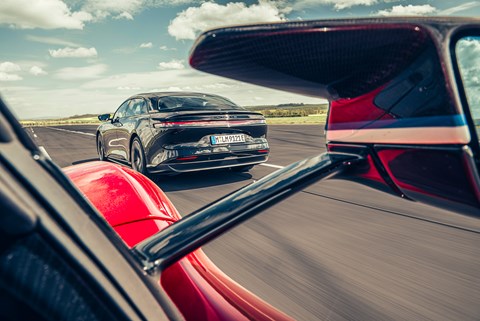
Time to drive. The car drops lower in Sport, the seats hug you like an overly-familiar auntie and, with oodles of cold-tyre wheelspin, even in the dry, you’re off and running. What follows is a bewitching reminder of Lotus’s ability to weave magic in the most unlikely places. Were this car the work of a Chinese newcomer with no emotional baggage we’d be losing our minds about the way it drives.
The direct, super-precise steering mean you guide the car effortlessly, the chassis balance far pointier than you’d expect looking at the thing. The ride, so deliciously languid in Range and Tour, never totally settles in the feistier drive modes. But on the flipside you’ll find levels of agility and composure that make a more compelling argument for the validity of the Lotus badge on the nose than you might be ready to hear.
Response to any of the primary controls is instantaneous, such that you really need to relax into the car to get the most from it, guiding it with just as much Jim Clark finesse as your mortal form can manage. Speed acquisition is explosive. The brake pedal’s better resolved than in most other cars here, even the Taycan, and you’re soon sweeping through curves with an ease and a grace to make your brain ache. Corner speeds are ballistic. Push really hard and the composure will slip, the spell broken as the car’s myriad hard-working systems throw in the towel, unable to keep up with the heavyweight and ever-shifting demands placed upon them. But that point never comes on the road. And it’s a measure of the Eletre’s essential rightness that when the rain comes and the grip levels plummet it’s still an impressive steer, with a level of feel that lets you feed the car confidently into streaming wet corners and, with your right foot, drive out right on the limit.
If the Battista and Eletre represent bookends of sorts, in body style if nothing else, the Lucid Air, BMW i5 M60 and Model S Plaid are the centre ground – family saloons turned hot rods.
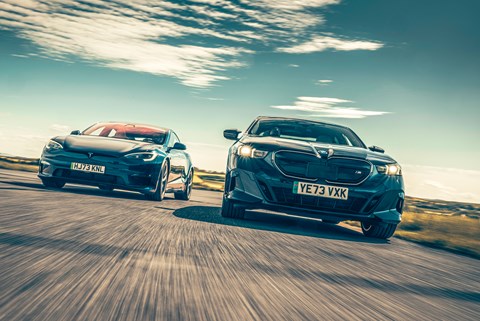
And the Tesla is the hottest of three. Find the space and the grip levels to exercise its raw power and the effect is startling, disconcerting even. The launch is brutal, and there’s barely any let-up deep into six figures, this fairly ordinary looking saloon piling on speed like a falling falcon with folded wings. This decadent performance is hitched to that aloofness common to all Teslas, and it’s a weird combination. Overly assisted and largely inert, Elon’s cars feel giddyingly light on the road. Combine the speed, the ethereal sense of detachment and the mostly empty interior and the effect is almost discombobulating, particularly when you factor in this test car’s Kubrick-esque white leather. This lighter-than-air hyper artificiality is kind of fun in a Model 3. But in the Plaid you long for something real to cling to. Where the Hyundai Ioniq 5 N moves with a physicality you can work with, the Model S gives you nothing, and doesn’t encourage exploration of its limits.
The steering’s disconcertingly light and light on feel, the brake pedal mushy and indistinct and the front axle too keen to wash wide, particularly in the wet. (By contrast the Taycan Turbo GT’s nose goes after your chosen line like Liam Neeson looking for another errant family member.) Switch to Track mode, confirm in response to a pop-up that warns of the need to try to avoid overheating the brakes (good luck with that), and the pushy understeer is replaced by rampant on-tap power oversteer of a kind that’s both fun and alarming.
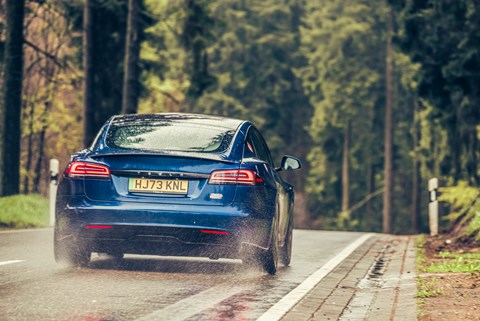
The Plaid works much better on the road. And as a long-distance EV it remains light years ahead, combining a soothing ride with to-die-for efficiency (the Model S goes more than three miles to the Eletre’s two), effortless route/charging stop planning and Tesla’s massive and still mostly under-used Supercharger network.
The Lucid takes Model S levels of speed and efficiency but serves them up in a less wilfully weird package. There’s ballistic straight-line speed whenever you want it, but it’s delivered so softly and smoothly there’s no sense of exhilaration. And that lack of edge or rawness defines the Air Dream Edition, a vastly spacious luxury jet of an EV with none of the rawer, racier granularity of the new triple-motor Sapphire.
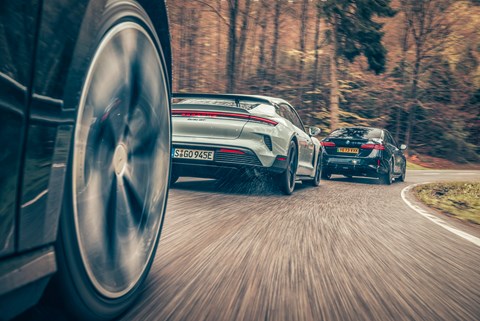
That car, effectively Lucid’s Air GT3 or CS and unavailable for this test, will surely deliver the driving engagement we seek, as might the imminent-in-Europe Pure, with its smaller battery and single driven axle. At it is, while the Air feels more cohesive than the Tesla and free of the contradiction at the heart of the i5 (short-ranged GT, anyone?), the long-legged Lucid is just too comfort-orientated to thrill. It is gorgeous inside and out, with a distinctive and delicious design aesthetic that extends to every touch point, not least the UX, where a clearly vast development spend oozes from every menu and graphic. And this thing is built to travel. At the Nürburgring, charged to 87 per cent, the display indicates that both London and Paris are within striking distance.
The BMW i5 M60 can only dream of such self-determination. With around 240 miles of real-world range, its suitability for epic long-distance driving is somewhat undermined by its inability to go long distances. But get past that and the i5 has a lot going for it, even if clammy-palmed thrills aren’t on the menu. The interior is beautiful, probably the second nicest here after the Eletre’s, and the car’s cross-country composure is quite something to behold, the BMW feeling compact and athletic after the big Americans, even if/perhaps because it lacks their heavyweight straight-line speed.

The chassis summons incredible grip, wet or dry, from efficiency-orientated EcoContact tyres, and the deft damping, accurate steering and beautifully calibrated powertrain make going really fast perhaps less demanding than in any BMW before it. Just don’t expect to remember much about the drive, other than the vaguely Interstellar soundtrack that accompanies greedy use of the throttle pedal.
Pursue conventional EV engineering to its big-budget conclusion and you arrive at the Taycan Turbo GT, the most powerful production Porsche yet, an object lesson in precision and a car we’ll get to in a moment. But what if there’s another way? What if you decide EVs would benefit from the stuff that made driving a piston-engined car enjoyable? What if you decide that engine noise enhances the experience, even if it is synthetic, and that gearshifts bring crucial punctuation to performance, helping your mind read and understand the car’s speed and effort? And what if you decide you like the way power, torque and revs interact, and that you might programme your EV to feel the same, even if it lacks the combustion that gave rise to that interplay organically?
Follow that line of thinking and you end at the Hyundai Ioniq 5 N, a car that drives like a love letter to the great four-wheel-drive hot hatches of the past and present, cars like the Lancia Delta Integrale, Ford Focus RS and Toyota GR Yaris, despite lacking an engine or gearbox. Shot through with original thinking and an infectious sense of fun, the 5 N is a car Porsche wouldn’t let itself make – but that we’re glad Hyundai has.
Ignore numbers like 641bhp, 3.4sec 0-62mph and, if you can, 2235kg. They suggest an awkward and unwieldy dragster of a hot hatch. Nothing could be further from the truth. A low-temperature warning pings up as I climb in and wake the powertrain. Thumbing an N button brings on an idle noise (dubbed N Active Sound+) and already I’m laughing, wondering if I need to give the non-existent engine block and its oils a few minutes to warm up. Nah.
Flying between the trees, the road wet from earlier rain but bright with blue skies overhead, the speed with which the Hyundai works its magic is breathtaking. The N gets a quicker steering rack and unique dampers (two things on a very long list of bespoke parts) and the effect is transformative, the 5 summoning plenty of grip and, crucially, real feel as you begin to flow, nuzzling up to the limit quickly and comfortably. There’s a welcome cushion of understeer, just to help you along, but it’s easily countered with a lift. Within minutes the corner speed you can carry, not to mention the great slugs of power you can feed in right from the apex, defy belief. The damping too is exquisite, as is the brake feel, and while there’s bodyroll – lashings of it compared to the Taycan – that’s okay. It helps you read the car; trust it, exploit it.
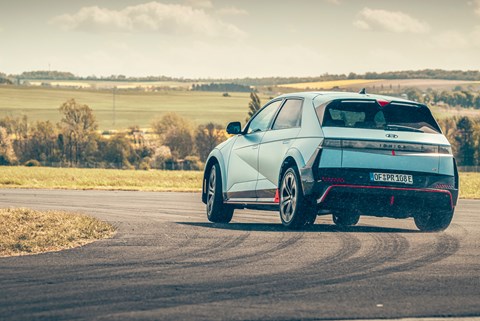
And as if I wasn’t having enough fun, know too that I’m tugging on gear paddles (disappointingly cheap and flimsy-feeling gear paddles, it must be said) and enjoying the full cacophony of a highly-strung, forced-induction performance petrol engine being worked hard. The tone deepens with more throttle, the torque tails off as you hang onto gears too long and, when you fail to shift in time, there’s a hard rev limiter to blunder into, just like the old days. The ‘modelling’ – I’m not sure what else to call it – of a paddleshift transmission at work is so authentic there’s even a moment’s pause and a thud as the next ratio in the double-clutch gearbox pops into place. And you’re thinking, ‘What ratio?!’ Hold on, ‘WHAT DOUBLE-CLUTCH GEARBOX!?’ It’d be preposterous were it not so well realised and so effective.
Where the 5 N is a puppy, keen to let you scratch its tummy the moment you make eye contact, the Porsche stands apart like a Boston Dynamics robo-dog, gimlet-eyed and keen to get on with the job.
Whatever that job, be it lapping a circuit or crossing Germany, the GT’s ready. It nails the basics, with a peachy driving position (the Hyundai’s wheel doesn’t drop low enough), an actual on/off button (so many EVs do without these, frustratingly, though I guess the Tesla generation can’t miss what it never had) and basic drive mode and damping controls familiar from any other Porsche. (Paddles are a Turbo GT-specific addition, with the left one flicking between two very light levels of regen and the one on the right summoning another 161bhp, for 1093bhp.)
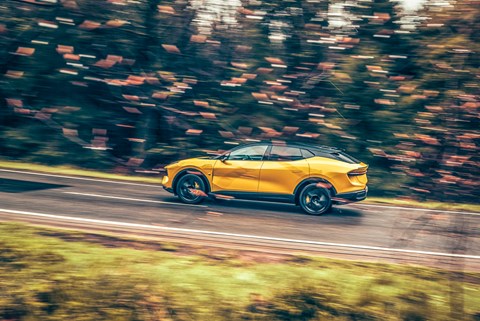
You’ll likely never get used to the power, and I won’t waste your time trying to describe it. Suffice to say it’s always just kind of there, at a level far beyond your needs or desires, just the moment you need it. Extend the twin-motor powertrain for any meaningful length of time and your socks will be blown not just off your feet but out of the car, out of the country and way out to sea. The standouts are the steering, on balance the best here, that GT Porsche combination of total body control with actual suspension pliancy, and the front axle, which smiles at your initial ideas of what might constitute an appropriate entry speed before politely requesting that you try harder. Load the nose a little and just let the car, which rotates sweetly for such a big device, do the rest.
There are chinks. The brake pedal has too much initial slack, and then ramps up the braking effort too quickly, apologetically almost, triggering the ABS until you’re used to it. And the seat height, never an issue in lesser Taycans, suddenly feels a couple of inches too high.
By most objective measurements this is the best car here. Eschew the Weissach pack and you retain the rear seats. Do that and the Taycan is the car the i5, Model S and Air all want to be when they grow up (though if the Tesla and the Lucid could hang on to their range and efficiency, that’d be great). Effortlessly faster than the Hyundai everywhere and the only car here to able to stay in the same postcode as the Battista, the Porsche is a beautifully resolved machine of majestic bandwidth.

But the Taycan Turbo GT takes life very, very seriously, and we came to be free. Free to do what we wanna do. And we want to get loaded. And we wanna have a good time.
The Da Vinci modes: our explainer
Pininfarina Battista
Adjusted by? Twisting a dial in the door.
Best of the bunch? Customisable Caraterre, and not just for its gorgeous Italian name. All the power but with a supreme level of adjustability to the dampers and steering.
And the worst? Calma, effectively the Battista’s range mode. To be used only when the alternative is walking.
Feeling lucky? Then go Furiosa. Unlocks all the performance, scrambles brains.
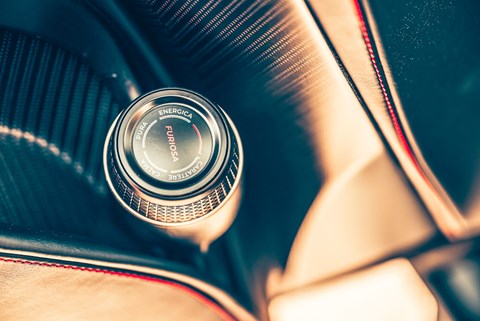
BMW i5 M60
Adjusted by? Switch and screen prod.
Best of the bunch? Sport. Wonderfully weighted steering and an instant BMW familiarity. It means you can jump in and go in the i5 in a way you can’t with the others.
And the worst? ‘Digital Art’, which appears to do little beyond changing the lighting.
Feeling lucky? The i5 is pretty strait-laced. Have it in Sport with the DSC limited and the full Hans Zimmer electric soundtrack.
Porsche Taycan Turbo GT
Adjusted by? Twisting dials on the wheel.
Best of the bunch? Sport Plus with the PASM dampers set to Sport – the perfect balance between outright performance and comfort; agility without the ride being too brittle.
And the worst? Range. If that’s your priority you may have bought the wrong Taycan. Feeling lucky? Attack mode, activated by tugging the right paddle, brings on an extra 161bhp for 10 seconds. Like it needed it…
Lotus Eletre R
Adjusted by? Clicking the paddle on the right up and down.
Best of the bunch? Sport. Best-weighted steering, more than enough pace and still with a pliant ride. A stupendously good all-rounder. Special mention to the glorious paddles.
And the worst? Track mode. Just too lairy and easy to get sideways for a car like this.
Feeling lucky? Hypocritical, yes, but also Track. Does things an SUV shouldn’t.

Hyundai Ioniq 5 N
Adjusted by? Cluster your favourites, then just click the wheel-mounted buttons.
Best of the bunch? N Active Sound+ is genius in the way it replicates the noise of an engine and even ‘thumps’ as you change gear. N Drift mode makes even a novice feel like a god.
And the worst? None of them.
Feeling lucky? The Supersonic active sound makes it sound like a fighter jet. Gimmicky, yes, but sure to generate smiles.
Tesla Model S Plaid
Adjusted by? Via the giant screen, obviously.
Best of the bunch? Plaid. Yes, the Model S’s monumental output makes it a bit of a one-trick pony, but there’s something hilarious about a perfectly family-friendly car having this much power.
And the worst? Redundant Sport. Chill is great on a cruise but Plaid is perfectly manageable.
Feeling lucky? Self-explanatory Drag Strip will happily re-arrange your face.

Lucid Air Dream Edition
Adjusted by? Tapping on the screen.
Best of the bunch? Lucid doesn’t bombard you with modes. Swift gets the balance right between silly acceleration and comfort.
And the worst? The Air’s three modes all feel pretty similar, so it’s not really worth ditching any particular one of them.
Feeling lucky? Sprint offers insane acceleration for a luxury limo, but this version never feels all that engaging.
Pity the poor tyres

EVs present new challenges to tyre engineers because of the weight of the batteries and instant torque of the electric motors. EV performance cars are even worse. In the case of the Battista there’s 1874bhp and 1726lb ft, all being fed to the tarmac by combined contact patches not much bigger than an A4 sheet.
Ray Collier, MD and chief engineer of tyre test and development firm Tread, is unequivocal in his recommendation: ‘Buy an EV-specific tyre; better still, buy one with an OEM approval marking. The breakaway characteristics in an EV tyre [the way it goes from grip to slip] are more pronounced because of the car’s weight and torque.
‘It needs to be more progressive and I pay particular attention to the wet performance because that means it’s operating at a safer level in challenging conditions.’
A stiffer structure to cope with the weight gives more precise steering but it places higher demands on the rubber, so if the compound grip isn’t high enough, then you get the dangerous snap breakaway.
Hankook, supplier of the Formula E tyre, uses natural oils and resins to try to balance less abrasion with better grip.
The final two
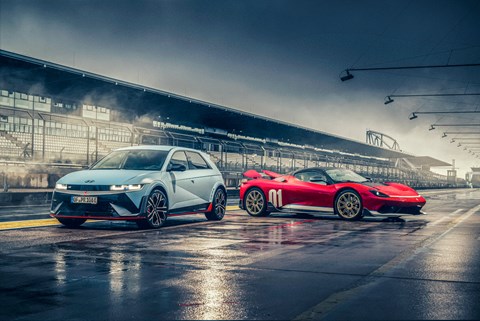
Standing trackside, the sky ablaze with amber evening light, I’m watching our two finalists do their thing. The Hyundai visibly rolls on turn-in, howls through the apex at a rate entirely at odds with its boxy silhouette and then, just as it’s looking hooked up for a quick exit, smears into power oversteer, broadsiding its way through the never-ending left-hander, the whine of its hard-spinning motors melding with tortured P-Zero Pirellis and the bass drumming of outside rear wheel on rumble strip. Remember the Renault Espace F1 and the Volvo 850 estate BTCC racer? There’s a touch of the same bewitching incongruity about N’s Ioniq 5.
Meet Sebastian Koch, the man behind the on-track racket. A zero-bullshit individual with the patience of a triggered mousetrap, Koch likes his cars honest, fast and immune to fatigue. De-rating powertrains and overheating Tesla brakes? As head of testing for CAR’s German sister title Auto Zeitung, he has no time for such frailties, and certainly can’t forgive them.
By rights Koch should hate everything about the Hyundai, one of the least honest cars to ever make production. Instead he adores it. ‘You get out exactly what you put in: steering, power, throttle response, brakes,’ he gushes, door open, brakes ponging. ‘And it’s so easy to drift – you don’t even need to be in Drift mode [though there is one of those, naturally, plus the option to balance the torque split front/rear just as you want it]. Just switch the ESC off and off you go. It’s very responsive yet very stable. I really didn’t expect this. I thought it’d be a digital experience yet somehow it isn’t.’
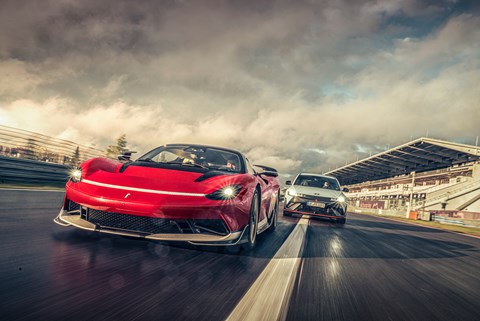
The Eifel are doing what the Eifel do, switching from high summer to midwinter in the space of a few minutes. It looks hairy out there, and in these less than perfect conditions it’s the Hyundai I want to drive first. Would you mind, Sebastian?
We whine past the shuttered pit garages as a humble EV (and a good one at that) before rolling out on the track, our progress serene but for flying grit in the wheel wells and the rain on the screen. Configured this way the Ioniq 5 N’s paddles control regen and there is no fake noise. It’s barely any slower – all of the chassis good stuff is present and correct, naturally – but the experience is undoubtedly less rich. Feeling your way, understanding the circuit, reading the car – all of these things are more difficult outside of N mode; more austere and one-dimensional somehow.
So push the button, get on the paddles and revel in a car that manages to stuff so much of what makes the likes of the Focus RS and GR Yaris so special into an EV. Like those cars, the Hyundai isn’t circuit stiff. And like those cars it’s a hatchback you drive as much with the throttle pedal as with the steering wheel. Keep it neat, rail around the outside to stay off the slippery laid-down rubber and lean on the traction-rich four-wheel drive. Or let your hair down, get loose and relish the ease with which the Ioniq is pushed past its limits and recovered time and again, the car flattering like few I’ve ever had the good fortune to drive. Every input yields the exact response you intended. Turn-in is sharp and accurate, the steering precise and rich in feel and there’s real magic in the chassis’ combination of feel and adjustability. I have, I realise between bouts of uncontrollable giggling, found our winner.
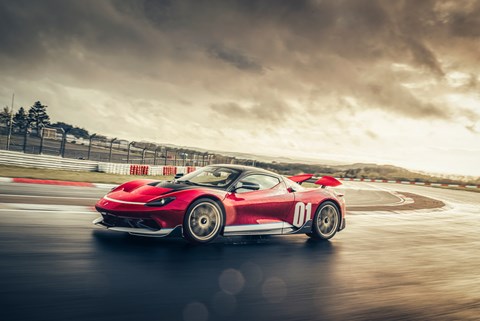
The Battista is different gravy, of course, and takes second place only because its interstellar performance means it’s forced to take life a little more seriously than the Hyundai. Intimidating until you drive it and awe-inspiring wherever you’re sitting, it is no plaything. But the Pininfarina is still hugely engaging and rewarding to drive, ⊲ and a fascinating counterpoint. Where the Hyundai begs that you explore its limits, the Pininfarina is dedicated to exploring yours.
Almost every aspect of the established supercar driving experience is present and correct here, not least the rampant butterflies in your belly as you approach and the conflicting desires to both smile at its raw beauty and to wince at its numbers: 1874bhp and £2.65m in the case of this Edizione Nino Farina example. Up close it’s all there: a door that takes most of the side of the car when it rises, making entry surprisingly easy; fabulous detailing (‘Pedal to the metal’ is machined into the gorgeous aluminium accelerator pedal, somewhat optimistically); and, as you finally sink into position behind the wheel, that sense of becoming part of the very structure of the car, such that you’re not so much sitting in it as wearing it.
Of course the price demands that the on-track performance is several orders of magnitude above even the Porsche. Rest easy, it is. As with the Taycan, you start out rocketing between corners before emergency braking for them. But soon enough the Pininfarina taps you on the shoulder for a little chat. ‘Everything you think you know?’ it mutters, looking away into the middle-distance for emphasis. ‘Forget it. I have re-written the rules. Let’s play.’
So you start to trust this extraordinary machine, aware that it hasn’t simply redefined your understanding of how a car can accelerate; it’s thoughtfully done the same with braking and cornering, so that as you start to build some semblance of a flow your driving is elevated to a level you didn’t even know existed.
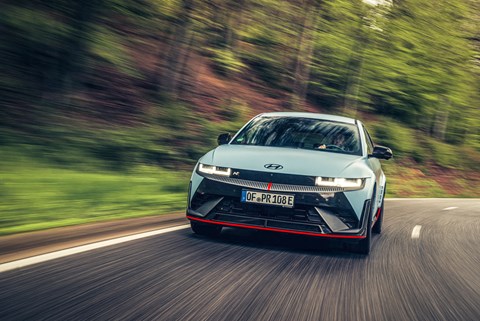
It’s still you; little old you. But the car’s plucked you from the universe you understood and ushered you into one most will never see. Like a quad-motor black hole, the Battista is a gateway to forces and speeds and sensations well beyond anything you’ve likely experienced before, and with that privilege comes the sense of awe and wonder so crucial to machines of this ilk – no-limits voyages into the previously unimaginable. As such, the freedom to exercise the Battista’s serene savagery is bittersweet, the euphoria of the moment tempered by the truth that it will not come again.
What a difference two years makes. The quality of this field versus 2022 defies belief. But there’s still a long way to go. Clearly weight and price are the pressing issues. There isn’t a car here that comes in under two tonnes or £65k. We’re making progress, yes, but dramatically dropping battery size (which would reduce weight and price) without sacrificing range feels unlikely in the short term.
But after the initial shock of the new the EV is finally starting to evolve as a driving machine. We now have both a scintillating hot hatch and a transcendental hypercar. And with those bookends in place, the future looks bright.